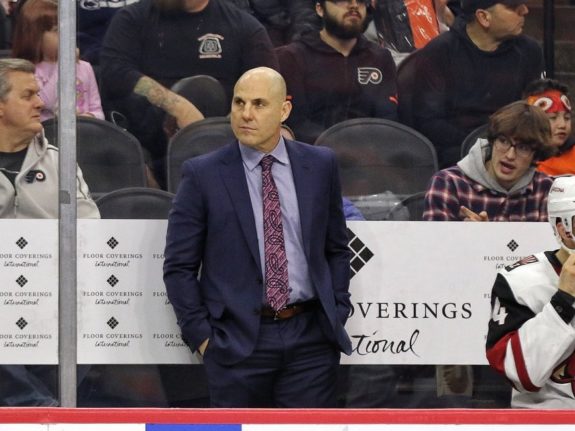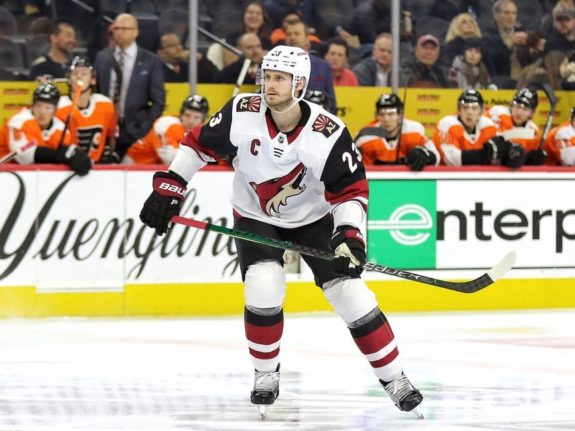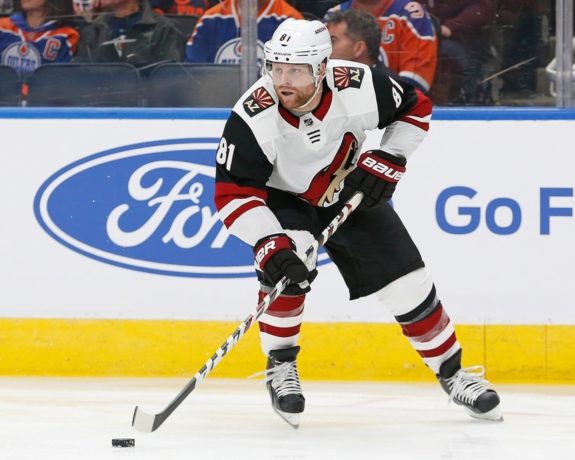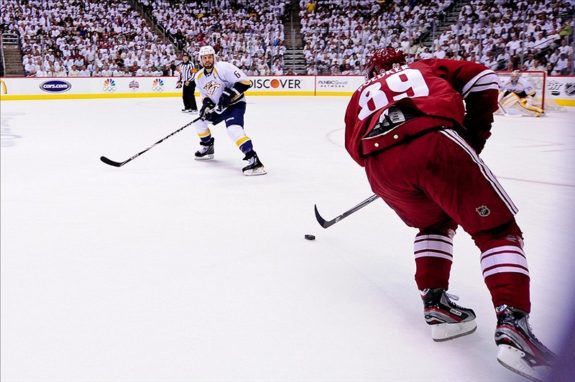
 Louis Pannone
The Hockey Writers
Louis Pannone
The Hockey Writers
53
Reads
0
Comments
Coyotes’ Playoff Hopes on Life Support
Let’s not sugarcoat things. The Arizona Coyotes had an absolute nightmare of a Western Canada road trip over the past few days – one which has put their playoff hopes in grave danger.
After picking up a massive come-from-behind victory over the Vancouver Canucks on Wednesday, the ‘Yotes followed that up with visits to the Calgary Flames and Winnipeg Jets to close out their final big roadie of the season. On Friday in Calgary, Arizona scored on their first shot on goal, and, on Monday in Winnipeg, they held a 2-0 lead after the first period.
It’s hard to envision the team getting off to two better starts on the road, but the Coyotes somehow managed to earn zero points from those two games. In the first case, they were outscored 3-1 by the Flames over the final 58:49, while in the other, they did not score again and surrendered four unanswered goals to the Jets.

This, sadly, has become the expectation in Coyotes’ road games as of late. After a 5-2 win at the Florida Panthers on Jan. 7, the ‘Yotes sat atop the Pacific Division with a 25-16-4 record and owned the league’s second-best road record at 14-6-3. Since then, though, they’re 2-11-1 in 14 road contests, and 8-13-4 in 25 games overall.
Trending in the Wrong Direction
The Coyotes’ record as of late speaks for itself, but a deeper look at the statistics reveals some more deeply troubling trends. This season, the team has lost seven times in regulation when holding a lead after the first period. The league average for that stat is three regulation losses.
When trailing after two periods, the Coyotes have just two wins this season, two fewer than the NHL average. When scoring first, Arizona has 10 losses, three more than the NHL average. When allowing the first goal, they have come back to win just nine times – three fewer than average.
Additionally, the power play, while operating at a respectable 19.2 percent success rate this season (18th in the league), never seems come through in times when the Coyotes desperately need a goal. Arizona received third-period power plays in both the Flames and Jets games while trailing by one, but came through on neither occasion and lost in regulation both times. The last time Arizona scored a game-tying or lead-changing power-play goal was in a loss to Dallas Stars back on Feb. 19, and the last time one came in the third period was in a Feb. 15 victory over the Washington Capitals.

Arizona’s power-play struggles can be traced back to the captain, Oliver Ekman-Larsson, who has produced next to nothing when skating at 5-on-4 in 2019-20. OEL has recorded just two power-play goals (PPG) and five power-play assists (PPA) this season, four of which were secondaries. This drop-off in production is especially mind-blowing when considering that, in his six previous seasons, Ekman-Larsson averaged 8.2 PPG and 12.2 PPA per year for the Coyotes.
His play this season has been unacceptable not just for a captain, but also for a supposed franchise defenseman who will earn $8.25 million per year until 2026-27. Not only has his play on the offensive end of the ice dropped off of a cliff, but Ekman-Larsson has also been a disaster defensively as well. He routinely is beaten up the ice for breakaways and odd-man rushes and frequently takes bad penalties as a result, one of which resulted in Mike Hoffman’s game-winning third-period power-play goal for the Panthers on Feb. 25 in Glendale.
Ekman-Larsson has also struggled with tasks as simple as keeping the puck in at the line in the offensive zone. The Coyotes need more from their highest-paid player over the final 12 games, and for the next seven years, for that matter, if they’re going to get to where they want to go.
Kuemper’s Absence Not the Issue
Much has been made of the impact that Darcy Kuemper’s injury had on this season, but let’s be absolutely clear – goaltending has not been the cause of this stretch of atrocious hockey. Adin Hill and Antti Raanta played above average hockey during Kuemper’s absence – the impact of his injury on the team performance, if any, has been purely psychological.
While Kuemper was on the shelf with a lower-body injury from Dec. 20 to Feb. 22, the Coyotes allowed 2.79 goals per game in 28 contests. That was the fifth-best figure in the NHL, and teams with markedly worse goaltending managed to be better than the ‘Yotes over that stretch.

The issue, which has lingered throughout the entirety of Rick Tocchet’s tenure as Arizona’s head coach, is the offense. This year, the Coyotes added Taylor Hall, Phil Kessel, and Carl Soderberg to a group that scored 209 goals, or 2.55 per game, last season. You’d imagine that the influx of offensive talent would significantly improve things, but that really hasn’t been the case.
This season, with all of that extra talent, the Coyotes have increased their scoring output by just 0.16 goals per game, which comes out to around one extra goal per six games played. They’re in the bottom-10 of the league in offense, and are on pace to score 222 goals for the season.
That seems bad enough, but looking at a much bigger sample size reveals the scope of Arizona’s offensive issues. Since Tocchet took over behind the bench, the Coyotes have averaged 2.59 goals per game in 234 games played. That’s the third-worst figure in the NHL, and only the Detroit Red Wings and Anaheim Ducks have been worse in the last three seasons.
It’s absolutely unacceptable to add players of Soderberg, Kessel, and Hall’s caliber to this group and still fail to make the playoffs. This is a team that was decimated by injuries last year but still hung around and contended for a playoff spot until the last week of the season before ultimately finishing with 86 points, four fewer than the Colorado Avalanche.
This season’s Coyotes have dealt with injuries like any other NHL team, but the forward group has largely avoided downtime, as nine forwards have skated in at least 66 of the team’s 70 games. This isn’t including Hall, who was brought in on Dec. 16, or Christian Fischer and Michael Grabner, who regularly rotate in and out of the lineup as the extra forwards.

The only players who have missed significant time, other than goaltenders, are Niklas Hjalmarsson, Jason Demers, and Brad Richardson, none of whom are counted upon to provide offense on a nightly basis. There’s no excuse for this team to be on the same 86-point pace they finished last season with.
Where Do We Go From Here?
At the very least, Arizona needs to win 8 of their final 12 games to even have a chance at earning one of the wild-card spots in the Western Conference. An 8-4-0 run, which would get this team to 90 points (and in no way guarantees a playoff spot, by the way), doesn’t seem like it would be out of the question for most contending teams in the NHL.

At this point, though, it’s looking like the Coyotes are not one of those teams. In order to find eight wins on the schedule, we have to go back to Arizona’s 6-3 win over the San Jose Sharks on Jan. 14, which was 56 days ago. Including that win, the Coyotes are 8-11-3 in their last 22 games – that’s the third-worst record in the NHL over that span. Only the San Jose Sharks and Detroit Red Wings have been worse. The best 12-game stretch for this team in 2019-20 was a 9-2-1 run from Oct. 10 to Nov. 4, which was part of an outstanding start that seems oh so long ago.
Despite all of their struggles, the schedule sets up favorably for Arizona to make a run down the stretch. 8 of the final 12 contests will come on home ice, and the furthest road game will take place in Denver, Colorado.
It all starts on Thursday night at Gila River Arena – the ‘Yotes will begin a five-game homestand by hosting the Canucks, and they need to earn no fewer than eight points during that stretch in order to realistically stay alive in the playoff race.
They’re already behind the eight ball, though, as they face a three-point deficit for the No. 8 spot with two teams ahead of them, all of whom have games in hand.
There is no more room for error. The can can’t be kicked down the road any further. Time is running out. It’s now or never. Whatever cliche you choose, the reality is that the Coyotes need wins, and they need them now.
The post Coyotes’ Playoff Hopes on Life Support appeared first on The Hockey Writers.
Popular Articles

















































 Blackhawks Chicago
Blackhawks Chicago Panthers Florida
Panthers Florida Penguins Pittsburgh
Penguins Pittsburgh Rangers New York
Rangers New York Avalanche Colorado
Avalanche Colorado Kings Los Angeles
Kings Los Angeles Maple Leafs Toronto
Maple Leafs Toronto Bruins Boston
Bruins Boston Capitals Washington
Capitals Washington Flames Calgary
Flames Calgary Oilers Edmonton
Oilers Edmonton Golden Knights Vegas
Golden Knights Vegas Senators Ottawa
Senators Ottawa Lightning Tampa Bay
Lightning Tampa Bay Flyers Philadelphia
Flyers Philadelphia Islanders New York
Islanders New York Sabres Buffalo
Sabres Buffalo Red Wings Detroit
Red Wings Detroit Devils New Jersey
Devils New Jersey Hurricanes Carolina
Hurricanes Carolina Blue Jackets Columbus
Blue Jackets Columbus Predators Nashville
Predators Nashville Stars Dallas
Stars Dallas Jets Winnipeg
Jets Winnipeg Wild Minnesota
Wild Minnesota Blues St. Louis
Blues St. Louis Mammoth Utah
Mammoth Utah Sharks San Jose
Sharks San Jose Ducks Anaheim
Ducks Anaheim Canucks Vancouver
Canucks Vancouver






